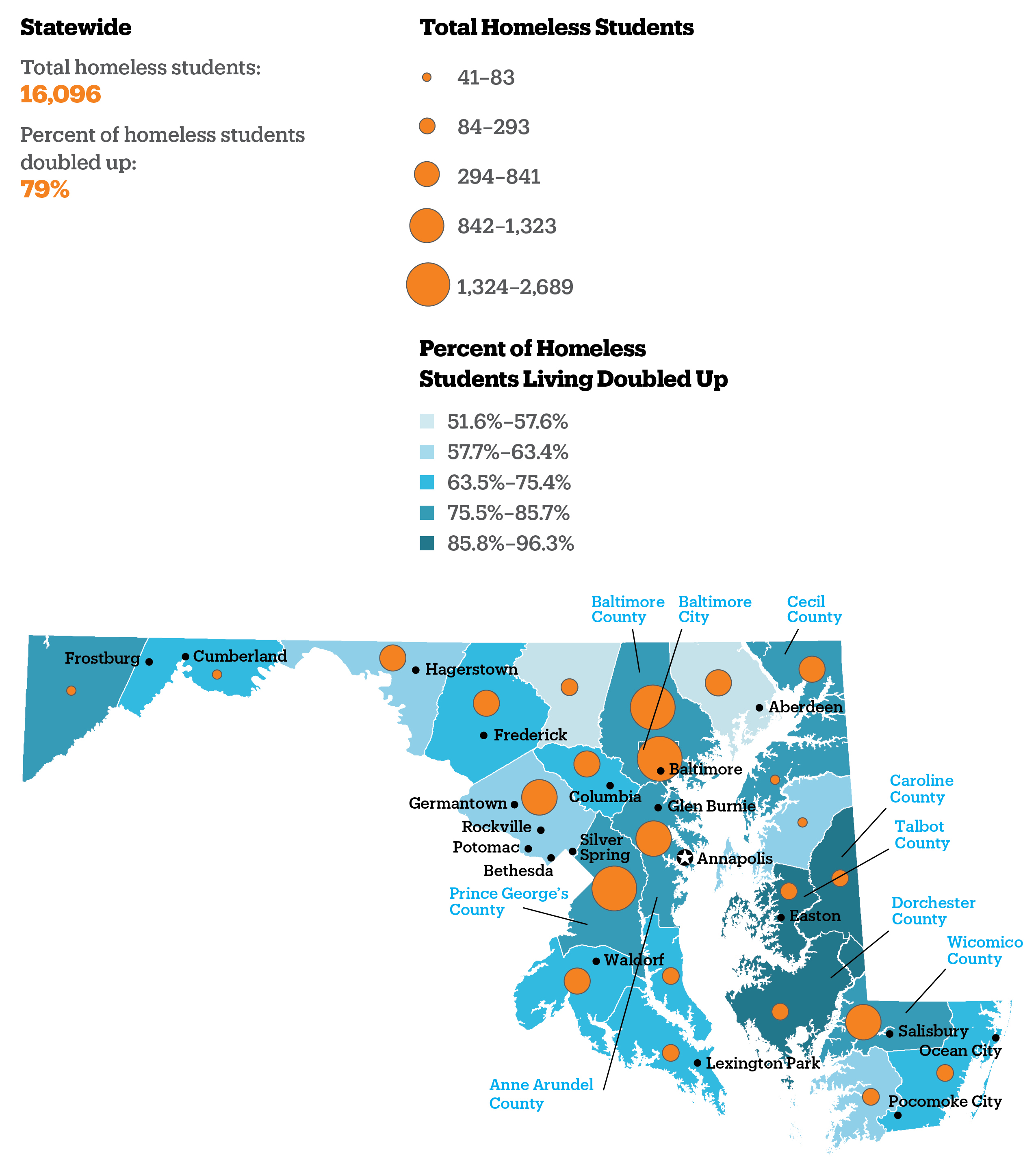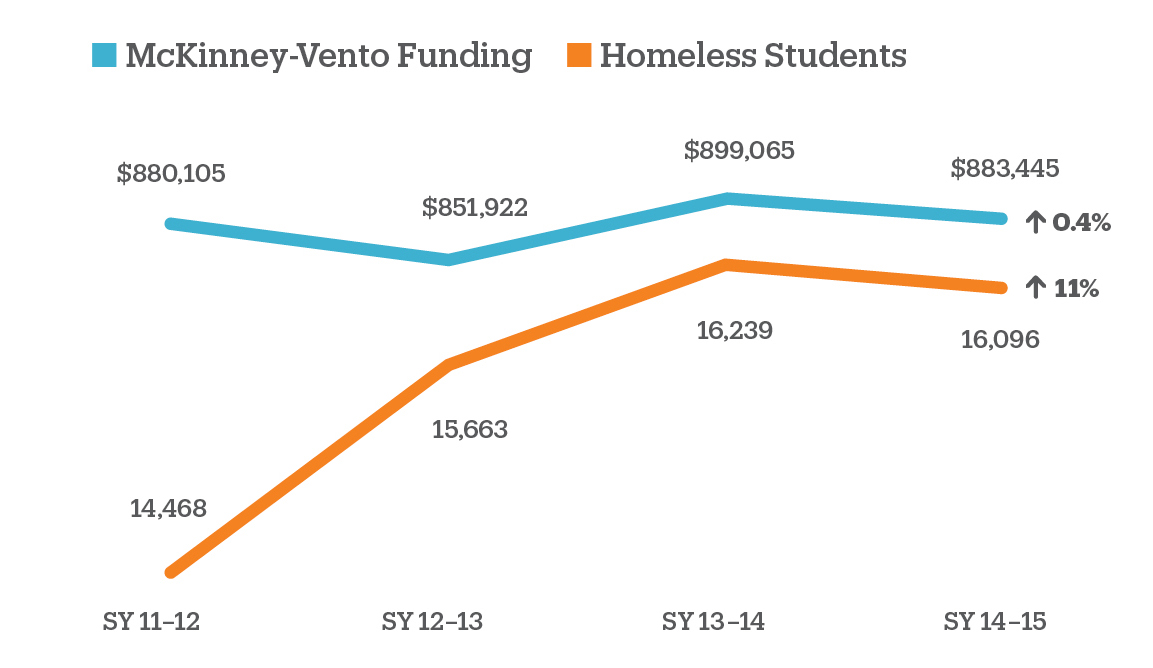Student Homelessness Snapshot
July 2017
This snapshot is part of a series analyzing student homelessness in all 50 states and the District of Columbia. Visit www.ICPHusa.org for more information.
- In the 2014–15 school year, Maryland had 874,514 students enrolled in 25 school districts (local education agencies).
- That year, there were 16,096 homeless students in the state, making up 1.8% of total enrollment.
- Maryland had the 25th highest number of homeless students and the 33rd highest rate of student homelessness in the U.S.
- School districts with the highest rates of student homelessness were Wicomico County (8%) and Cecil County (5%).
Figure 1
Number of Homeless Students and Percent Living Doubled Up
By School District, SY 2014–15
The U.S. Department of Education’s definition of homelessness includes students who are “doubled up,” or have no option but to stay with others in overcrowded, often unsafe living conditions.

Source: U.S. Department of Education, Homeless Student Enrollment Data by Local Educational Agency School Year 2014–15.
- Three school districts had over 2,000 homeless students (Baltimore County, Prince George’s County, and Baltimore City). In Wicomico and Cecil Counties, over five percent of students were homeless, close to three times the state average.
- In four school districts, at least 90% of homeless students were sleeping in a doubled-up living arrangement (Talbot County, Dorchester County, Baltimore City, and Caroline County). Five school districts had over 1,000 homeless students living doubled up (Baltimore County, Prince George’s County, Baltimore City, Wicomico County, and Anne Arundel County).
Figure 2
McKinney-Vento Funding and Number of Homeless Students
SY 2011–12 to SY 2014–15
The Education for Homeless Children and Youth program, established by McKinney-Vento, is the primary source of federal funding for homeless students in elementary and secondary school.

Source: U.S. Department of Education, State Funding History Tables by Program, Education Department Budget History State Tables, FY 1980–2014; National Center for Homeless Education, Federal Data Summary School Years 2011–12 to 2013–14 Education for Homeless Children and Youth, November 2015; National Center for Homeless Education, Federal Data Summary School Years 2012–13 to 2014–15 Education for Homeless Children and Youth, December 2016.
- Since SY 2011–12, Maryland’s McKinney-Vento funding increased 0.4%, to $883,445. Over the same period, the number of homeless students rose 11%, to 16,096. Maryland had the 27th highest rate of growth in student homelessness nationwide during that time.
- On average, Maryland received $54.89 per homeless student in SY 2014–15, down from $60.83 in SY 2011–12 (a decrease of 10%). Nationally, the per-student average for SY 2014–15 was $50.08
Figure 3
School Districts Potentially Under-Identifying Homeless Students
By School District, SY 2014–15
School districts with lower ratios of homeless students to free-lunch eligible students are likely under-identifying those not in shelter.

Source: U.S. Department of Education, Homeless Student Enrollment Data by Local Educational Agency School Year 2014–15; National Center for Education Statistics, Local Education Agency (School District) Universe Survey Directory Data, SY 2014–15; National Center for Education Statistics, Public Elementary/Secondary School Universe Survey Free Lunch Data, SY 2014–15.
- Forty-four percent of Maryland’s school districts received McKinney-Vento subgrants, and 66% of the state’s homeless students lived in a district with a subgrant. Non-grantee districts with the most homeless students included Baltimore City and Montgomery County.
- In Maryland, 48% of school districts had a ratio of homeless students to free-lunch eligible students smaller than the statewide average, including Prince George’s County and Harford County, which received subgrants.
Figure 4
Proficiency in 4th Grade Reading and Math
SY 2014–15
Student performance in early grades is a strong predictor of high school graduation.

Source: U.S. Department of Education, ED Data Express, SY 2014–15; U.S. Department of Education, State Assessments in Reading/Language Arts and Mathematics School Year 2014–15.
- Statewide: On average, homeless students were proficient in reading at a rate 23–29 percentage points lower than all students. In math, homeless students were proficient at rates 22–23 percentage points lower than all students.
- A closer look: Across all grades, Carroll County Public Schools, 30 miles northwest of Baltimore City, had the largest achievement gap in math between all students (57%) and homeless students (20–24%). Queen Anne’s County Public Schools, along the eastern shore of the Chesapeake Bay, had the largest achievement gap in reading between all students (51%) and homeless students (≤20%).
Figure 5
Homeless Students with Additional Support Needs
By School District, SY 2014–15
Students with disabilities or limited English proficiency may have difficulty accessing additional support services if they are homeless.

Source: U.S. Department of Education, Homeless Student Enrollment Data by Local Educational Agency School Year 2014–15.
- In Allegany and Carroll Counties, at least 25% of homeless students were identified as having a disability, over twice the average rate for all students and almost 1.5 times the average rate for homeless students.
- In three school districts, over 15% of all homeless students had limited English proficiency, over twice the statewide rate for homeless students (Queen Anne’s, Montgomery, and Caroline Counties).
Figure 6
Where Homeless Students Live, by Population Density
SY 2014–15
Families in rural areas or small towns often have fewer shelters or services to turn to for assistance.

Source: U.S. Department of Education, Homeless Student Enrollment Data by Local Educational Agency School Year 2014–15; National Center for Education Statistics, Education Demographic and Geographic Estimates (EDGE) Program, Geographic Indicators and Identifiers 2014–2015.
- In Maryland, 66% of homeless students lived in suburban school districts, compared with 78% of all students.Among cities, two districts had over 1,000 homeless students each (Baltimore City and Wicomico County).
- Homelessness was disproportionately seen in Maryland’s urban areas. Despite enrolling only 12% of the total student population in the state, these districts accounted for 21% of all homeless students.
Homeless students are too often overlooked by policymakers when talking about education policy. Improving outcomes and supports for homeless students reduces the burden on teachers, parents, and schools who struggle to help students cope with the trauma of homelessness along with the challenges of poverty.
Questions for educators and state/local legislators to consider
- Do you know how many homeless children live in your town? In your state?
- Is your school district a McKinney-Vento grantee? How much funding does it receive? How is it used?
- What supports are being provided to help homeless children toward better educational outcomes?
- Are the challenges that homeless students face, such as chronic absenteeism and difficulty traveling to and from school, being addressed?
- Are the educational needs specific to homeless students being identified?
- Does your public school have a dedicated liaison whose priority and focus is the needs of homeless students?
- Do schools coordinate with the shelter system or service delivery system?
- Are homeless students being granted access to services to which they are entitled (e.g. transportation, tutoring, special education, health care, food)?
This snapshot is part of a series analyzing student homelessness in all 50 states and the District of Columbia.
Visit www.ICPHusa.org for more information. Data tables for the figures seen here will be available at www.ICPHusa.org starting in July 2017.
Source Notes